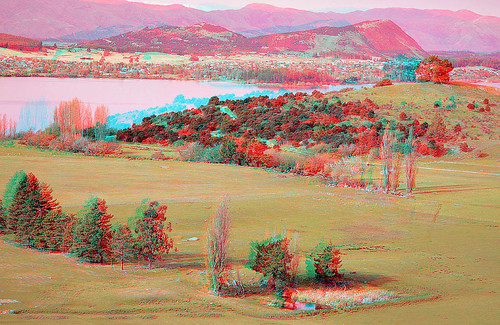
AnaglyphsRetinex theory of colour vision
|
ColorCode (Yellow/Blue) |
A method developed in Germany has an image on a flat surface viewed as an anaglyph from 45 degrees. By 3D rendering in perspective, objects jump up out of the page. Originally done by drawing, it is easier photographically and then post-process in Photoshop to produce the perspective distortion. Here is an example from Steve Body.
Phantograms do not work well on LCD computer monitors because if you look at them at an angle from below, the image becomes very dark. They are usually seen printed.
Any stereo pair shot at an angle to the horizontal can be converted to a phantogram, adjusting the perspective by eye. To make very accurate phantograms requires tedious measurements, but that is not necessary for fun pictures. The method is similar to "falling frame" windowing, with a final perspective correction and resizing to allow viewing at an angle. Experience with phantograms will give you the courage to apply perspective and distortion corrections to standard stereoscopic pairs, as is hinted at in the "making anaglyphs" section. Suddenly you will have much more control over the third dimension in your photography.
This anaglyph of Lake Wanaka is remarkably popular on Flickr,
but none of the commentators have reailsed it is a "partial phantogram."
This adds to the 3D effect, even when seen straight on, which does work on LCD monitors.
The illusion may explain why the image has been successful.
There is another on my Flickr Photostream, which is also popular, so see if you can find it!
(anaglyph by John Wattie, Click on it for bigger versions from Flickr.)
Terry Wilson has phantograms which can be seen on a computer screen, including stereo images of Mars. She uses the simple idea of placing the phantogram at the correct angle and photographing it. There are numerous examples on her web site. Phantaglyph is a commercial name.
There is even a lens which will take anaglyph stereo pictures directly. Only the out of focus areas are red or cyan, and one is in front and the other behind the focal plane, so they cause a 3D effect. This extraordinary Vivitar lens is no longer available. Information here. image here box set
A home-made version by Guillaume Dargaud works , but again only on out of focus objects, so images are taken with the lens wide open to reduce depth of field. It is probably fair to say the 3D depth is modest to minimal.
There are also amazing photographs of Antarctica and mountaineering pictures on his site.
Bens lens (Benslens) is a mirror attachment on the front of your camera lens, which automatically makes anaglyphs.
The mirrors are arranged so the left mirror sends light through a red filter and the right through a cyan half reflecting mirror, which combines the red and cyan channels before sending on through the camera lens.
Put anaglyph filters side by side in the condenser of a monocular microscope and photograph the result. Instant anaglyph! Better still, 3D movies of microscopic creatures. (Wim Van Egmond).
Dr. Imre Zsolnai-Nagy (again!) has invented a macro anaglyph lens, described in his own delightful and remarkably clear "Hungarian English" here. He is a busy Urologist who manages to find time for many 3D experiments.
Partially colour-blind people sometimes claim difficulty seeing anaglyphs. The colours are just for channel separation and you may think colour blindness would not matter. However, discussing it with such folk suggests they may not see anaglyphs well. The red channel is sometimes too dark. The cyan channel colours seem "wrong." It may depend on which version of colour blindness you have, since others seem to have no difficulty.
Many people with true colour vision also dislike anaglyphs, because you effectively become partially colour-blind while viewing them.
Folk with a dominant eye may suppress the non-dominant eye, which is only partially voluntary. (For example, sighting a rifle with both eyes open, but suppressing one to only see the rifle sights). If suppression happens while viewing an anaglyph, there is trouble seeing 3D.
Further information here
An advantage of anaglyphs is seeing the image at up to full screen size on the computer, or even more if you are prepared to pan. (e.g. 3D toadstool). X and U stereo can only use up to half the screen.
After viewing red/cyan anaglyphs for a prolonged period, take the dog outside in the dark night for a walk. If you find your right eye has gone partially blind, do not panic.
Fighter pilots and radiologists wear red goggles before entering a dark place, because red light allows human eyes to become dark adapted. Viewing RC anaglyphs has a red filter only over the left eye, which becomes dark adapted. Keep walking in the dark and gradually your right eye will also develop night vision and in about 5 to 10 minutes will be as good as your left eye.
Anaglyph goggles do not cause night-blindness, they actually cure it, but only in the left eye!
Glasses available {here} .
The glasses use micro prisms to make the various colours deviate, in the order they show in the rainbow. (ROYGBIV). Red deviates the most, towards the nose in each eye, and so seems closest. ChromaDepth does not use stereo pairs and will not work on an anaglyph. It is often used by graphic artists rather than photographers.
Map images can be done with ChromaDepth to produce 3D heights.
Under-water photography works well because the change to blue with distance is just what ChromaDepth needs.
Yellow flowers come out with perfect colour in red/cyan anaglyphs.
(Stereo image by John Wattie. Click for bigger versions)